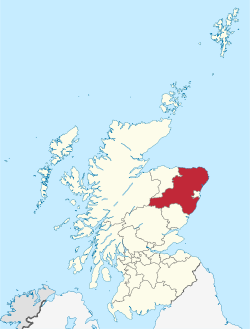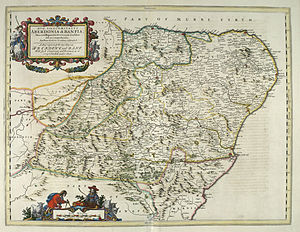Aberdeenshire
Aberdeenshire Aiberdeenshire Siorrachd Obar Dheathain | ||
|---|---|---|
 | ||
|
MPs
|
| |
| • MSPs |
| |
| Area | ||
| • Total | 2,437 sq mi (6,313 km2) | |
| • Rank | Ranked 6th | |
| • Density | 110/sq mi (42/km2) | |
| GSS code | S12000034 | |
| ISO 3166 code | GB-ABD | |
| Website | www | |
Aberdeenshire (
It takes its name from the
Traditionally, it has depended economically on the primary sector (agriculture, fishing, and forestry) and related processing industries. Over the last 40 years, the development of the oil and gas industry and associated service sector has broadened Aberdeenshire's economic base, and contributed to a rapid population growth of some 50% since 1975.[2] Its land represents 8% of Scotland's overall territory. It covers an area of 6,313 square kilometres (2,437 sq mi).[3][4]
History

ABERDONIA & BANFIA

Aberdeenshire has a rich prehistoric and historical heritage. It is the locus of a large number of
Since
Aberdeenshire played an important role in the fighting between the Scottish
These new families set the stage for the upcoming rivalries during the 14th and 15th centuries.
After the end of the
The present council area is named after the
Demographics
The population of the council area has risen over 50% since 1971 to approximately 262,690,[10] representing 4.7% of Scotland's total. Aberdeenshire's population has increased by 9.1% since 2001, while Scotland's total population grew by 3.8%. The census lists a relatively high proportion of under 16s and slightly fewer working-age people compared with the Scottish average.[2]
Aberdeenshire is one of the most homogeneous/indigenous regions of the UK. In 2011, 82.2% of residents identified as 'White Scottish', followed by 12.3% who are 'White British', whilst ethnic minorities constitute only 0.9% of the population. The largest ethnic minority group are Asian Scottish/British at 0.8%.[11] In addition to the English language, 48.8% of residents reported being able to speak and understand the Scots language.[12]
Settlements
The largest settlements in Aberdeenshire are:
| Settlement | Population | |
|---|---|---|
| Mid-2010[13] | (mid-2020 est.)[14] | |
| Peterhead | 17,790 |
19,060 |
| Inverurie | 11,590 |
14,660 |
| Fraserburgh | 12,540 |
12,570 |
| Westhill | 11,220 |
12,110 |
| Stonehaven | 10,820 |
11,150 |
| Ellon | 9,910 |
10,070 |
| Portlethen | 7,130 |
8,940 |
| Banchory | 7,030 |
7,440 |
| Kintore | 4,180 |
4,700 |
| Turriff | 5,020 |
4,700 |
Huntly
|
4,570 |
4,550 |
| Banff | 3,720 |
4,000 |
| Kemnay | 3,710 |
3,890 |
| Macduff | 3,910 |
3,830 |
| Laurencekirk | 2,650 |
3,140 |
| Oldmeldrum | 2,990 |
3,120 |
| Blackburn | 2,720 |
3,050 |
| Newtonhill | 3,080 |
3,010 |
| Aboyne | 2,440 |
2,920 |
| Mintlaw | 2,610 |
2,800 |
Economy
Aberdeenshire's Gross Domestic Product (GDP) is estimated at £3,496M (2011), representing 5.2% of the Scottish total. Aberdeenshire's economy is closely linked to Aberdeen City's (GDP £7,906M), and in 2011, the region as a whole was calculated to contribute 16.8% of Scotland's GDP. Between 2012 and 2014, the combined Aberdeenshire and Aberdeen City economic forecast GDP growth rate is 8.6%, the highest growth rate of any local council area in the UK and above the Scottish rate of 4.8%.[2]
A significant proportion of Aberdeenshire's working residents commute to Aberdeen City for work, varying from 11.5% from Fraserburgh to 65% from Westhill.
Average Gross Weekly Earnings (for full-time employees employed in workplaces in Aberdeenshire in 2011) are £572.60. This is lower than the Scottish average by £2.10 and a fall of 2.6% on the 2010 figure. The average gross weekly pay of people resident in Aberdeenshire is much higher, at £741.90, as many people commute out of Aberdeenshire, principally into Aberdeen City.[2]
Total employment (excluding farm data) in Aberdeenshire is estimated at 93,700 employees (Business Register and Employment Survey 2009). The majority of employees work within the service sector, predominantly in public administration, education and health. Almost 19% of employment is within the public sector. Aberdeenshire's economy remains closely linked to Aberdeen City's and the North Sea oil industry, with many employees in oil-related jobs.
The average monthly unemployment (claimant count) rate for Aberdeenshire in 2011 was 1.5%. This is lower than the average rate of Aberdeen City (2.3%), Scotland (4.2%) and the UK (3.8%).[2]
Major industries

- Energy – There are significant energy-related infrastructure, presence and expertise in Aberdeenshire.[15] Peterhead is an important centre for the energy industry. Peterhead Port includes an extensive new quay with an adjacent laydown area at Smith Quay, is a major support location for North Sea oil and gas exploration and production and the fast-growing global sub-sea sector. The Gas Terminal at St Fergus handles around 15% of the UK's natural gas requirements, and the Peterhead power station is looking to host Britain's first carbon capture and storage power generation project.[2] There are numerous offshore wind turbines near the coast.
- Fishing – Aberdeenshire is Scotland's foremost fishing area. In 2010, catches landed at Aberdeenshire's ports accounted for over half the total fish landings in Scotland and almost 45% in the UK. Along with Aberdeen City, Peterhead and Fraserburgh ports provide much employment in these sectors. The River Dee[5]is also rich in salmon.
- Agriculture – Aberdeenshire is rich in arable land, with an estimated 9,000 people employed in the sector, and is best known for rearing livestock, mainly cattle. Sheep are important in the higher ground.[5]
- Tourism – this sector continues to grow, with a range of sights to be seen in the area. From the lively Cairngorm Mountain range to the bustling fishing ports on the northeast coast, Aberdeenshire samples a bit of everything. Aberdeenshire also has a rugged coastline, many sandy beaches and is a hot spot for tourist activity throughout the year. Almost 1.3 million tourists visited the region in 2011 – up 3% on the previous year.[16]
- Whisky distilling is still a practised art in the area.[5]
Governance
Notable features



The following significant structures or places are within Aberdeenshire:
- Balmoral Castle, Scottish Highland residence of the British royal family.[5]
- Bennachie
- Burn O'Vat
- Cairness House
- Cairngorms National Park
- Corgarff Castle
- Crathes Castle
- Causey Mounth, an ancient road
- Drum Castle
- Dunnottar Castle
- Fetteresso Castle
- Fowlsheugh Nature Reserve
- Haddo House
- Herscha Hill
- Huntly Castle
- Kildrummy Castle
- Loch of Strathbeg
- Lochnagar
- Monboddo House
- Muchalls Castle
- Pitfour estate
- Portlethen Moss
- Roman Camp
- River Dee
- River Don
- Sands of ForvieNature Reserve
- Slains Castles, Old and New
- Stonehaven Tolbooth
- Ythan Estuary Nature Reserve

The Dee, Aberdeenshire's longest river
Hydrology and climate

There are numerous rivers and burns in Aberdeenshire, including
Notable residents
- John Skinner, (1721–1807) author, poet and ecclesiastic. Penned the famous verse, "Tullochgorum".
- Hugh Mercer, (1726–1777), born in the manse of Pitsligo Kirk, near Rosehearty, brigadier general of the Continental Army during the American Revolution.[17]
- Alexander Garden, (1730–1791), born in Birse, was a noted naturalist and physician. He moved to North America in 1754 and discovered two species of lizards. He was a Loyalist during the American Revolutionary War, which led to the confiscation of his property and his banishment in 1782. The gardenia flower is named in his honour.[17]
- John Kemp, (1763–1812), born in Auchlossan, was a noted educator at Columbia University who is said to have influenced DeWitt Clinton's opinions and policies.[17]
- George MacDonald (1824–1905), author, poet, and theologian born and raised in Huntly.
- Dame Evelyn Glennie, DBE, born and raised in Ellon on 19 July 1965, is a virtuoso percussionist and the first full-time solo percussionist in 20th-century western society. She is very highly regarded in the Scottish musical community and has proven that her profound deafness does not inhibit her musical talent or day-to-day life.
- Evan Duthie, (born 2000), an award-winning DJ and producer.
- Peter Nicol, MBE, born in Inverurie on 5 April 1973, is a former professional squash player who represented first Scotland and then England in international squash.
- Peter Shepherd, (1841–1879), Surgeon Major, Royal Army Medical Corps
- Johanna Basford (born 1983), illustrator and textile designer[18][19]
- Iona Fyfe (born 1998), award-winning Scots singer and musician.
References
- ^ Land Register Counties & Operational Dates Archived 28 September 2013 at the Wayback Machine
- ^ a b c d e f "Aberdeenshire Council – Profile 2012" (PDF). Archived from the original (PDF) on 21 February 2014. Retrieved 11 July 2012.
- ^ "Aberdeenshire profile" (PDF). Aberdeenshire Council. Archived from the original (PDF) on 7 March 2014. Retrieved 9 October 2013.
- ISBN 978-0-230-37769-1.
- ^ ISBN 978-1-59339-837-8.
- ^ W. Douglas Simpson, "The Early Castles of Mar", Proceedings of the Society, 102, 10 December 1928
- ^ The Megalithic Portal and Megalith Map. "C.Michael Hogan, Elsick Mounth, Megalithic Portal, ed. Andy Burnham". Megalithic.co.uk. Archived from the original on 10 June 2011. Retrieved 6 July 2011.
- ^ Geni - William Leslie
- ^ The New Statistical Account of Scotland
- ^ "Mid-Year Population Estimates, UK, June 2021". Office for National Statistics. 21 December 2022. Retrieved 18 October 2023.
- ^ "Aberdeenshire Council Identity in 2011 Census" (PDF). Archived (PDF) from the original on 9 October 2022.
- ^ "What's happening in... Aberdeenshire's Towns Inverurie & Port Elphinstone" (PDF). August 2019. Archived (PDF) from the original on 9 October 2022.
- ^ "National Records of Scotland, Statistics and Data, Statistics, Statistics by Theme, Population, Population Estimates, Settlements and Localities, Archive, Mid-2010, List of Tables". Retrieved 19 July 2023.
- ^ "Mid-2020 Population Estimates for Settlements and Localities in Scotland". National Records of Scotland. 31 March 2022. Retrieved 31 March 2022.
- ^ Shepherd, Mike (2015). Oil Strike North Sea: A first-hand history of North Sea oil. Luath Press.
- ^ "Aberdeenshire Council – Profile 2012" (PDF). Archived from the original (PDF) on 21 February 2014. Retrieved 2 January 2013.
- ^ a b c Who Was Who in America, Historical Volume, 1607–1896. Chicago: Marquis Who's Who. 1963.
- ^ "Follow The Paper Trail". www.heraldscotland.com. Herald & Times Group. Retrieved 16 February 2016.
- ^ "Rough Cut Nation (Exhibition Notes)". National Galleries Scotland. National Galleries Scotland. Retrieved 27 February 2016.


